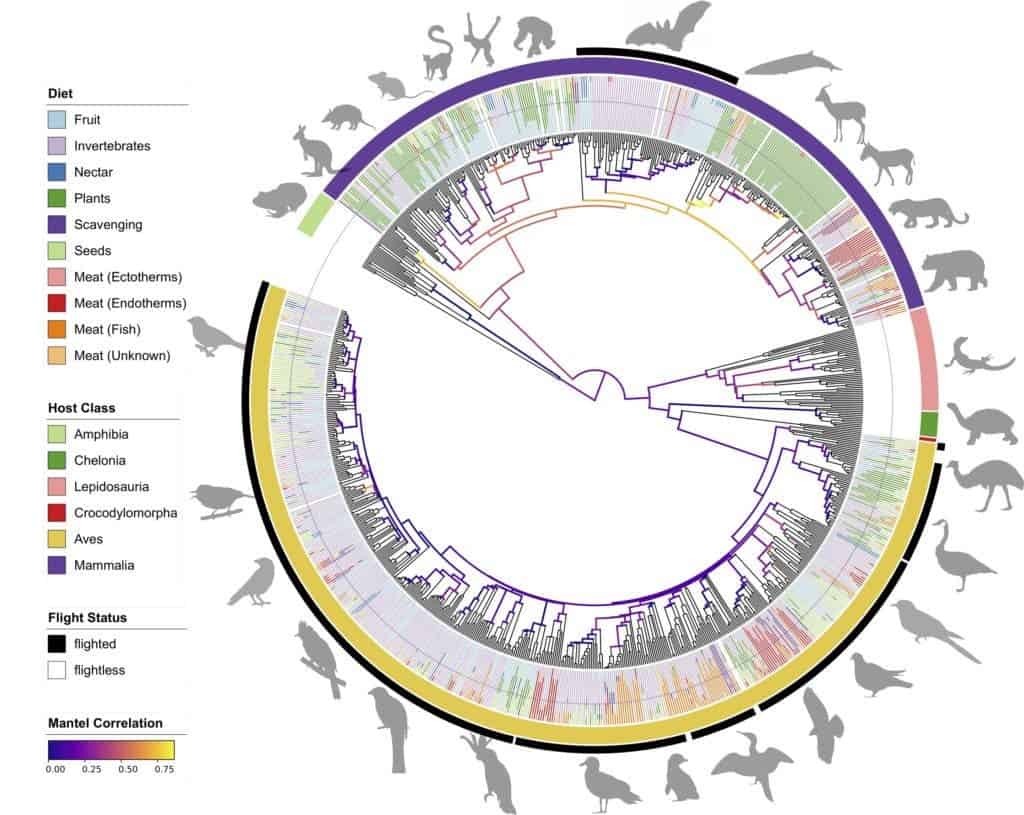Bats and birds don’t seem to need gut bacteria the way other animals do, a new study finds.
Our microbiota or microflora — communities of bacteria making home in our digestive tract — play quite a central role in our health and wellbeing. These tiny helpers aid us in fighting bad bacteria and aid digestion. It’s not just us. Most vertebrates rely on similar bacterial communities for the same tasks.

Image credits Se Jin Song et al., (2020), mBio.
But not birds and bats, a new study found. By drawing on field samples and museum specimens, a team of US researchers has compared the makeup of mammal, bird, reptile, and amphibian microbiota, finding that species which evolved for flight tend not to rely on symbiotic bacteria almost at all.
You can’t fly with us
“If you’re carrying a lot of bacteria in your gut, it can be pretty heavy and may take resources away from you,” says Holly Lutz, a research associate at Chicago’s Field Museum and postdoctoral researcher at the University of California San Diego and co-author of the study.
“So if you’re an animal that has really high energetic demands, say because you’re flying, you may not be able to afford to carry all those bacteria around, and you may not be able to afford to feed them or deal with them.”
The study is the first of its kind and the first to showcase how different the microbiota of flight-capable species are compared to those of other vertebrates. The team believes that the necessities of flight are exactly what caused this difference in gut bacteria.
To the best of our knowledge, animals that are closely related to each other have similar gut microbiomes, because they evolved together — a pattern referred to by scientists as phylosymbiosis. Thus, Se Jin Song, the paper’s co-first author from UC San Diego, says that before the study the team assumed they would “see similar associations between animals and their gut microbes when the animals shared a similar diet.”
“Our pie-in-the-sky idea was that flight could impose a similar type of selection on which microbes animals host,” he explains. “What was shocking was that we didn’t find that birds and bats share a similar microbiome per se, but rather that both lack a specific relationship with microbes.”
For the study, the team analyzed fecal samples from roughly 900 species of vertebrates on a global scale. Researchers, museum collections, and zoo directors from around the world participated in the efforts, which ranged from zoo work to venturing deep into remote Ugandan and Kenyan caves with a flashlight to collect samples from African bats.

Image via Pixabay.
After collecting the needed material, the team used high throughput genetic sequencing to process them. In essence, they extracted all DNA from all the samples, and then used individual genes to sift through the bacterial communities within each sample. For the final step, they pooled all of the data together to form the comparisons between species.
The microbiomes of bats and birds didn’t fit in with the rest of the vertebrates, the team found. While their gut bacteria makeup was quite similar, they had very little in common with other vertebrates. The team believes that it’s their shared lifestyle, not their ancestry (bats and birds are only very distantly related), that shapes their gut flora. In other words, their ability to fly.
Both groups evolved this ability independently, but no matter which way you cut it, flying is very energy-intensive and requires a light body. Bats and birds both have much shorter digestive tracts than comparable land mammals, and they both carry fewer bacteria, which likely helps reduce weight. The authors write that it’s also possible that diet plays a role here; due to the huge energy requirements of active flight, there may simply not be enough food to spare to maintain a symbiotic relationship with the bacteria.
Another important finding is that the few bacteria that do live in the digestive tract of both birds and bats tend to be very varied. Various types of individual bacteria live in the guts of different species of bats or birds, most other groups of amphibians, reptiles, and mammals apart from bats follow specific patterns.
“It’s almost like they’re just picking up whatever’s around them and they don’t really need their microbes to help them in ways that we do,” says Lutz.
“If we ever are putting ourselves in some kind of extreme situation where we’re disrupting our microbiome, there is something that we can learn from animals that don’t need their microbiomes as much.”
Lutz notes that this study wouldn’t have been possible without museum collections from around the world. Specimens of bird and bat kept in cryogenic chambers in the Field Museum’s Collections Resource Center were pulled out to help provide the broad samples needed for a study of this size.
“The scope of this paper —in terms of species that we sampled— is really remarkable. The diversity of collaborators that came together to make this study happen shows how much we can achieve when we reach out and have these big and inter-institutional collaborations,” says Lutz.
The paper “Comparative Analyses of Vertebrate Gut Microbiomes Reveal Convergence between Birds and Bats” has been published in the journal mBio.


